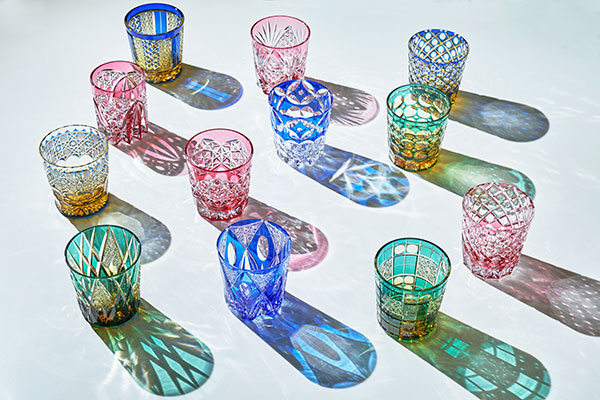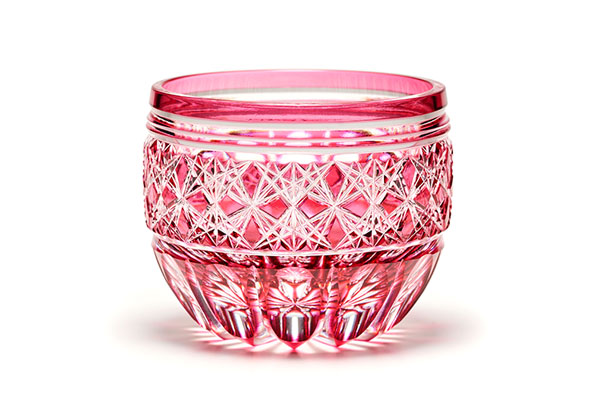
- Other crafts
- Tokyo
Edo kiriko cut glass Edo kiriko
Traditional glass from Tokyo
A feast for your eyes and fingertips
Description
What is Edo kiriko cut glass ?
Edo kiriko is the most famous glass craftwork in Japan. It was originally produced in the city of Edo which was Tokyo's name during the Edo period (1603-1868). Kiriko means "cut glass" so its name means "cut glass from the city of Edo". Edo kiriko sake glasses and other types of glassware are still popular today.
Originally, patterns were cut on a transparent and colorless glass surface. However, new techniques were introduced during the Meiji period (1868-1912), when Japan first opened its doors to the outside world after having isolated itself for over 200 years. The style of Edo kiriko made with colored glass started being produced in large quantities during this time. Today, Edo kiriko is known for its intricate designs cut into blue, red or other colored glass. The most typical design is called nanako or fish eggs because it is composed of numerous fine straight lines that resemble round fish eggs. However, a closer look reveals the design is actually composed of many small squares arranged side by side. Other quintessential Japanese designs include plants such as chrysanthemums or hemp leaves.
History

Edo kiriko is considered to have begun in 1834 in the late Edo period (1603-1868), when Kyubei KAGAYA, the owner of a glass wholesale firm in Edo, first tried to design a glass using emery powders.
During the Meiji period (1868-1912), as part of the government's policy of promoting Japanese industrialization, a modern glass factory was constructed, and in 1881, the government invited Emmanuel HAUPTMANN, a British cut glass engineer, to Japan. He taught his knowledge and techniques to the Edo kiriko artisans, which led to British cut glass technology merging with Edo kiriko techniques.
Furthermore, another famous cut glass style called Satsuma kiriko stopped its production at the end of the 19th century, resulting in many unemployed craftsmen migrating to Edo with their Satsuma kiriko traditions. Their technique of using color coated glass was soon absorbed into the production of Edo kiriko.
From the Taisho period (1912-1926) through the early days of the Showa period (1926-1988), cut glass was called wa glass (meaning "Japanese-style glass"). It became extremely popular and was used for drinking glasses, tableware or lamp shades. The main manufacturers of Edo kiriko were founded in the beginning of the 20th century and are still active today.
General Production Process
- 1. Marking Without drawing a design, simple grid lines are marked out on the glass to provide the framework of the design. The design grid is drawn on the glass's surface using a bamboo stick or brush with red iron oxide. Next, the base lines of the design are lightly etched using a whetstone. Relying on these fine marks and lines, the delicate patterns of Edo kiriko are created with the artisan's expertise and skills.
- 2. First cuts The base design is cut to about three quarters of the final width and depth. The surface of the glass is cut using a sand paste coated metal disc rotating at high speed. Generally emery powder with many abrasive particles are used to create the sand paste. The clear pattern border lines and the rough patterns are cut little by little. The balance between the thickness and depth of the cut lines relies upon the artisan's years of experience as there are no detailed sketches.
- 3. Adjustments The patterns cut in the second stage are adjusted and the surface is smooth polished in this process. A whetstone disc, natural or artificial, is used to cut fine patterns that cannot be created with the metal disc used in the prior process. This is the last cutting stage to complete the patterns so careful work is required to not leave any powder residue and to ensure a brilliant finish.
- 4. Polishing This is the final stage of production and it is usually carried out on soda-lime glass (most prevalent type of glass). The opaque surface left by the third stage is returned once more to its original transparent state, but now with the attractive shine and sparkle so typical of Edo kiriko. For high-class crystal glass, chemical processing with hydrofluoric acid may be applied too. Depending on the piece, a variety of different polishing discs may be used, such as paulownia wood discs, willow wood discs, hair brush discs or belt discs. By applying water and polishing powders, the work is polished to obtain a glittering finish. The particularly fine sections are often polished with a cloth or a brush. To complete the final polishing, a cloth buffing disc is used to bring out the sparkle and shine of the cut glass.
Where to Buy & More Information
Sumida Edo Kirikokan
-
Address
-
Tel.+81-3-3623-4148
-
ClosedSundays, Mondays, holidays and around the New Year
-
Business Hours10am to 5pm
-
Website
Edo Kiriko Cooperative Association showroom
-
Address
-
Tel.+81 3 3684 6321
-
ClosedMonday Closed (holiday sales and the next day time off in lieu)
-
Business Hours10:00 - 18:00 (Business hours change according to the season.)
-
Access3 minutes walk from Nishi-ojima station exit A2 (TOEI Shinjuku Line)
-
Website
See more Other crafts
- Edo kiriko cut glass
- Koshu lacquered deer leather
- Kyo folding fans
- Marugame uchiwa fans
- Boshu uchiwa fans
- Gifu lanterns
- Yamaga lanterns
- Kyo uchiwa fans
- Tendo Japanese chess pieces
- Edo glass
- Edo patterned paper
- Yame lanterns
- Owari Cloisonné
- Fukuyama Koto (Japanese Harp)
- Kyo art preservation
- Banshu fly-fishing flies
- Woodblock prints
- Koshu hand-carved seals
- Edo Hyogu (Art Mountings)
- Edo tortoise shell crafts
- Etchu Fukuoka Sedge Hats
- Gifu Japanese Umbrellas
- Nagasaki tortoise shell crafts
- Nagoya Sekku Kazari
- Sanshin
- Tokyo Koto (Japanese Harp)
- Tokyo Shamisen
See items made in Tokyo
- Edo kiriko cut glass
- Edo wood joinery
- Edo glass
- Murayama-oshima tsumugi silk
- Tokyo silverware
- Edo patterned paper
- Tokyo fine-patterned dyeing
- Edo bamboo fishing rods
- Tama brocade
- Hachio island silk
- Woodblock prints
- Tokyo textiles
- Edo-sekku doll
- Edo Hyogu (Art Mountings)
- Edo Oshi-e Pictures on Embossed Fabric
- Edo tortoise shell crafts
- Tokyo Honzome Chusen
- Tokyo Koto (Japanese Harp)
- Tokyo Plain Dyeing
- Tokyo Shamisen
- Tokyo antimony craft































































































































































































































































































